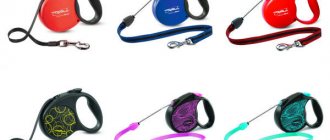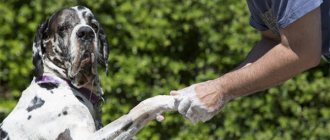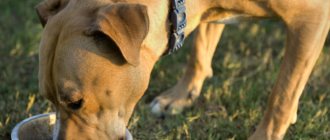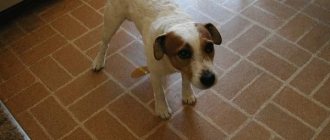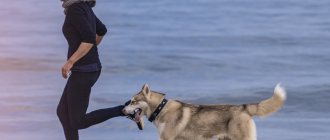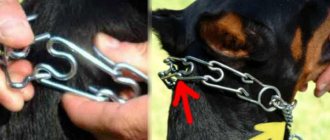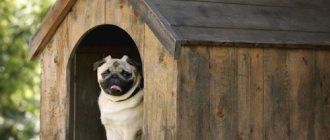A dog's life is surrounded by not very pleasant procedures: after walks you need to wash your paws, visit the veterinarian every few months, and some animals have to periodically visit the grooming salon. Burrs get stuck in the fur, claws have to be cut, teeth and ears have to be examined. The dog must be accustomed to all these burdensome but necessary procedures, and even from puppyhood.
We tell you how to accustom your dog to unpleasant procedures and gain its trust.
How to train a dog to trim its nails?
To accustom your dog to a haircut, you must first of all ensure that the procedure is painless for him.
It is advisable to give your pet different treats upon completion of the operation. Under no circumstances should you yell at your pet or show your anxiety. If you adhere to these rules, then you most likely will not have problems with haircuts, especially if you train your dog from puppyhood. It is more difficult to work with older dogs that have negative experiences. In this case, in addition to all of the above, it is worth giving the dog the opportunity to get used to the procedure. Make all the preparations necessary for cutting, but at first do not finish the job - let the dog get used to the tools and the situation. When she starts to behave calmly enough, you can start cutting her hair.
Grooming, trimming, cutting
- Lift the dog onto the table. Don't do anything else: praise her, feed her a treat.
- Take scissors or a clipper and let your dog sniff the tool.
- Touch it to the dog. Praise. Take the animal down and let it run around.
- Take up the exercises again, but now complete them by carefully cutting the fur or plucking out the hairs.
If you use a clipper, it will take time for your pet to get used to the noise.
Nuances of the procedure
The first nail trimming procedure for dogs is the most exciting. If something goes wrong, it will be difficult to persuade the animal for subsequent haircuts. Talk to the animal, take its paws in your hands and hold it for a while. Then you can bring the instrument to it and if the dog does not show its dissatisfaction, then it is ready for the procedure.
Preparation
Trimming nails at home for the first time can be inconvenient, so it's best to get a second person to help. Prepare in advance all the necessary tools and materials:
- cutters;
- nail file:
- antiseptic;
- cotton pads;
- hemostatic agent;
- treat for the dog.
Before cutting your dog's nails, you need to prepare cotton pads.
Long-haired dogs have the hair on their paws and between the toe pads trimmed. Carefully examine your pet's paws and claws. There will be no problems with light claws. The pulp is clearly visible on them. With black claws it will be a little more difficult.
The timing of the procedure matters. It is best to trim your dog's nails after eating or after a long walk. You cannot manipulate an animal if it is scared or irritated. Calm your pet and only then proceed with the procedure. The same rule applies to the owner himself. The dog will immediately feel his excitement and begin to worry.
Find a suitable location. It should be well lit with a flat surface. Small dogs can be placed on your lap. The surface is covered so that the animal does not slide on it. The dog lies on its side, legs extended forward.
Trimming Features
At the beginning, it is determined where to make the first cut. With light-colored claws everything is clear; the pulp is translucent, starting at the base, and reaches almost to the end. The place where it is not there and needs to be cut. Hold the paw firmly in one hand and the tool in the other. Gently place your finger between the pads and secure with your thumb. Try not to touch the space between the dog's toes, otherwise the animal will feel tickling and begin to reflexively jerk its paw.
Pay attention to the shape of the claws. If the tip is curved, cut off only it, leaving the straight part
To prevent delamination of the claw, the cut is made from top to bottom, placing the tool perpendicular to the claw. The blade of the nail clippers is held at an angle of 45 0 C. After proper trimming, the dog should not “click” its claws on the floor.
How to trim a dog's black nails? In cases where the soft tissue inside the claw is not visible, you need to be extremely careful. By touching it, you will cause severe pain to the animal and will completely discourage you from continuing the procedure. Cut gradually, starting 5 mm from the edge. If the cut is dry and peeling, you can cut further, but gradually. When you see dark tissue on the cut, you need to stop. After trimming, each claw must be filed with a file to get rid of sharp edges.
Between trimming the claws on the hind and front paws, you need to give the animal a break. Two to three hours is enough for the dog to calm down and the procedure can begin.
Praise and reward
During the nail trimming procedure, speak to the animal in a soothing voice, pet it, and encourage it. You can give your dog a cookie, bone, or other treat. To make your haircut easy and relaxed, take breaks from time to time. Finally, praise your pet, tell him he did well, and bark another portion of the treat. By remaining calm during the first procedure, the dog will understand that nothing terrible is being done to it, and in the future it will continue to behave calmly.
Washing paws
- Take the cloth you are going to use to wipe your dog's paws.
- Let your dog smell it. Be sure to praise and give a treat.
- Stroke your dog's paw with your hand.
- Try lifting your paw and stroking it. Repeat the exercises, do not forget to praise your pet. If the dog snaps or growls, return to step 2.
- Touch the dog's paw with a cloth.
- Repeat all steps. If the animal responds well, wipe its paws, praise it and release it.
Do all dogs need to have their nails trimmed?
Yes, almost all dogs need to have their nails trimmed. Small breeds (Yorkshire terrier, Chihuahua, Spitz, French bulldog, pug, Papillon, etc.) spend most of their lives in the arms of their owners or on sofa cushions. Therefore, trimming their nails should become a mandatory and regular procedure. This rule also applies to dogs of medium breeds (poodle, basset hound, boxer, etc.). The only exception would be very active dogs that spend several hours every day outside, running on hard asphalt surfaces and thus wearing down their claws.
Cost of cutting nails in a salon or veterinary clinic
Owners who for some reason cannot, do not want, or are afraid to care for their pets themselves should know how much it costs to trim a dog’s nails at a grooming salon or veterinary clinic. And here a lot will depend on the size of the pet, because the smaller the animal, the cheaper the service will cost. Thus, dogs of small breeds (Chihuahua, toy terrier, Pekingese, etc.) will have their claws shortened in a salon or clinic for 100-150 rubles. For medium-sized dogs (German boxer, Siberian husky, bull terrier, etc.) the procedure will cost from 200 to 200 rubles. Well, large dogs (Newfoundland, Caucasian and Central Asian shepherd dogs, etc.) will have their nails trimmed for 300-500 rubles.
By the way, in some establishments they evaluate not only the cutting of the claws itself, but also the restraint of the animal (you may need to pay an additional 100-150 rubles for this). In addition, there is the option of calling a specialist at home. The cost of such a service ranges from 500 rubles or more.
Method for trimming a dog's nails
The first thing to do is prepare your tools
. They must be of high quality and purchased in specialized stores. Because low-quality products may break during the procedure and thereby harm your pet. Naturally, their cost will be rather high. But, if you decide to carry out this procedure yourself, without involving specialists from a veterinary emergency center, then it’s worth spending the money.
You also need to prepare cotton wool and hydrogen peroxide
in case of injury to the animal.
It is best to use cotton pads
, since cotton wool has a fleecy structure and small parts of it can stick to the wound of the animal.
1 Caress the animal so that it is calm, and, if necessary, give something tasty.
2 Wash your paws well.
3 If the dog is small, place him on your lap. If the breed is large, place it on a mat.
4 Take the tool (claw clipper) in one hand, the paw in the other, and, stepping back two millimeters from the skin with blood vessels, cut off the claw. It's better to leave more distance
than to harm the animal.
If the animal has a light-colored claw, then the vessels are more visible in sufficient lighting. If the color of the claw is dark, you need to be more careful so as not to injure the paw. Broken skin causes profuse bleeding, you need to be very careful
.
If it so happens that the skin was touched while trimming the claws, you need to generously lubricate the damaged area with an antiseptic. Each trimmed claw must be filed.
In order for the animal to behave calmly and not show aggression during nail trimming, it must be accustomed to this process from a young age. If you are unable to carry out such a procedure on your own, you can use the services of our veterinary emergency center “YA-VET”. We know how to trim a dog's nails. An experienced specialist will visit your home, provide all the necessary documents about his qualifications and trim your pet’s nails. You may have a question about the cost of such a procedure. It is worth noting that the veterinary emergency center only has a loyal pricing policy. The price for cutting dog nails is quite affordable.
If you find an error, please select a piece of text and press Ctrl+Enter.
https://lovely-dog.ru/uhod-za-pitomtsem/kak-pravilno-podstrigat-kogti-sobake-kogterezom-v-domashnih-usloviyah/https://www.dobrovet.ru/stati/veterinariya/kak- strich-kogti-koshke-sobakehttps://ya-vet.com/vet-uslugi-dlya-sobak/kak-pravilno-podstrich-kogti-sobake
Ear cleaning
- Let your dog sniff the cotton swab.
- Touch your dog's ear with your hand.
- Repeat steps 1 and 2. After this, try to bend your ear and look inside. If all is well, give your pet a treat.
- Repeat steps 1, 2 and 3. It will be quick and easy if you have managed to consolidate the association with positivity. After this, carefully insert your finger into the dog’s ear and move it inside. Reward if the animal reacts calmly.
- Take some cotton wool and rub it on the inside of the dog's ear. Encourage and praise.
- Repeat all the above steps, and then wipe the dog’s ears. Give the animal treats and praise.
Properties of claws
You should start caring for a dog’s claws from an early age, while the pet is still a puppy, because its claws, although thin, are sharp: they can injure the bitch when feeding. And if the baby finds it uncomfortable to move due to overgrown claws, this will lead to incorrect placement of the paws or even dislocation.
Inside the claw of animals there is a pulp consisting of blood vessels and a bundle of nerves.
How often should you cut your dog's nails? On average, paws need to be treated once a month. However, the frequency will vary depending on the conditions in which the pet lives. And if he often walks on the asphalt, the claws wear down on their own. If not, you can’t do without a haircut.
A reliable indicator that the time has come is the clicking of claws on the floor. This is a sign that your pet is uncomfortable walking. And there is no need to wait, succumbing to the fear of causing pain. Neglecting paw treatment has bad consequences.
What happens if you don't trim your hair? If you delay processing, they will become too long, sharp, and bent.
For a dog this means the following:
- the claw wounds the skin until it bleeds, in this case an infection can enter the animal’s body, there is a high risk of developing purulent inflammation, and this can lead to blood poisoning, tissue necrosis, after which - amputation of a finger or even the entire paw;
- with such wounds it is painful to move, the gait changes, and as a result, posture is disturbed, coordination is lost, and muscle tone decreases;
- the pet injures itself and upon contact may, unwittingly, injure adult owners or children;
- a much less serious drawback: the dog will damage the floor or furniture while trying to sharpen its claws.
Since these toes do not touch the ground, it is difficult for your pet to grind down their claws.
Washing in the bath
- Bring your dog to the bathroom, but do nothing else, just praise so that the animal begins to associate the room with something good.
- Place your dog in the bath, but do not turn on the water. Allow her to leave on a separate command - for example, “Go for a walk.”
- Repeat the first two points periodically.
- Start running the water while your pet is in the bath, but don't wash him. Encourage. Repeat until the dog begins to be philosophical about water.
- Pour water on the dog, dry it with a towel, reward it.
Tools Needed to Trim Dog Nails
If you have gained courage and calmness (and they are needed here most of all!), then you need to stock up on items to care for your dog’s claws. First of all, buy dog nail clippers. They come in two types - wire cutters and guillotines.
Dog nail clippers are similar to pruning shears—one blade is straight and the other is curved.
A guillotine for cutting dog nails is something similar to pliers with a hole for the nail and handles that you press on.
To properly trim a dog's nails with a nail clipper, you need to be extremely focused and attentive.
Important! The ideal and correct material for nail clippers of any kind is brass or stainless steel. Don't buy cheap or flimsy looking tools.
The blades should be sharp and the handles should be rubberized and non-slip.
You also need to purchase a nail file to trim trimmed claws. There are also electric scratching posts - trimmers.
You will also need to put together a makeshift emergency first aid kit, which should include:
- hydrogen peroxide;
- chlorhexidine;
- talc (baby powder);
- potassium permanganate powder;
- flour (replacement of talc);
- sterile bandage (gauze);
- cotton pads;
- alcohol or vodka (for sterilizing wire cutters or guillotine).
Buy all this in advance and put it in one box.
How to trim nails
One of the fundamental factors for your success and the safety of your pet is attentiveness and concentration, so you need to approach preparation with all responsibility. Decide where you will trim your nails. It would be better if it was a table with a non-slip surface. Small dogs have their nails trimmed on their hands, and very large dogs have their nails trimmed on the floor. In any case, it is recommended to cover the working area with thick fabric or a non-slip mat.
The second stage of preparation is the right mood for both you and your pet. For your first haircut, it is better to enlist the help of family or a friend. Your hands will be busy, while the other pair will hold the dog, stroke its head, and scratch behind the ears. Throughout the entire procedure, you will speak to your client in an encouraging tone. Immediately before the haircut, you need to take the dog for a walk and actively play - this way the pet will be more relaxed.
A few more rules and useful tips:
- No matter how long the dog’s claws may seem, with regular trimming they will become shorter - the pulp literally retreats deeper into the claw, allowing it to be shortened.
- Try to regularly inspect your dog's paws, even if he actively walks and runs, his nails can successfully grow to an unnecessary length. If you have a small dog that prefers to sit in your arms rather than run, trimming its nails is a must.
- Haircutting tools are selected based on several factors, but the main one is quality. Blades must be made of hard metal and remain sharp. A dull nail clipper will not only the claw
, but can also crush it. - For your first, second, and possibly tenth haircut, accept the fact that you won't be able to trim all the nails in one go.
- If your pet has very hard claws, the paws should be soaked in warm water - this will soften the keratinized plates and, perhaps, relax the dog a little.
- Behave confidently; if you are worried, your pet will decide that he is about to undergo a really scary or dangerous procedure.
- And most importantly, never cut your nails if you are not sure where to cut! Contact a groomer or veterinarian who will be able to carry out the procedure based on experience and explain all the details to you.
It's time to look at practical tips on how to trim your dog's black nails. The difficulty is that the darker the claw
, the less likely it is to examine the pulp. In quadrupeds with light claws it is clearly visible when viewed from the side. Black claws are sometimes visible with a flashlight. In rare cases, especially in mongrels, only the claw on the dewclaw becomes visible.
The reference point for pulp length is the groove on the side of the claw. It is slightly shorter than the pulp. Not all dogs have a furrow, most often in four-legged dogs with long fingers and sharp claws.
Suppose you were still unable to discover how long the pulp stretches, what should you do in this case? There are two ways out:
- Filing the claws is the best option, allowing (with a persistent approach) to gradually shorten the claws without harm to the dog. With each layer of keratinized tissue removed, the pulp will retreat deeper into the claw. By removing the hard layer, you will promote faster natural abrasion of the claws.
- Cutting off a very thin layer of the claw and sharpening it with a file is a faster method, which is quite fair if there are grooves on the dog’s claws, that is, you roughly understand where the pulp is, but are not sure.
Trimming dog nails at home. Starring the dachshund Nyusha.
If your dog has black claws and the length of the pulp is not determined, it is advisable to have hemostatic drugs (wipes, powders) in your first aid kit.
How to care for your turtle's claws and beak
Trimming turtle claws
Living in natural conditions, turtles independently take care of the condition of their claws and beak. The same can be said about turtles, who have caring owners who adhere to all our recommendations. However, if the pet's diet consists primarily of protein foods (find out what turtles eat), and the turtle is kept on soft ground (on hay or sawdust), then its claws and beak may grow longer than expected. In this case, the owner must cut them (however, this only applies to land turtles; aquatic species of turtles are never cut; for them, long claws are the norm).
As a rule, a strongly overgrown beak and claws prevent the turtle from moving and eating normally. Therefore, arm yourself with wire cutters or Luer tongs and get to work.
How to trim a turtle's beak
It would be better not to cut off the excess extension of the turtle's beak, but to break it off or bite it off with your tools. Make sure that you expose the normal serrated edge of the beak so that you can trim it later with a file. A properly trimmed beak allows the jaws to close tightly, and during the procedure, if you do everything correctly, there should be no blood. If you injure a turtle, or find that it has an abnormal bite, contact a specialized turtle specialist - a veterinarian herpetologist. If the beak does not close after trimming, it is better to leave the excess stratum corneum intact.
How to trim a turtle's claws
For semi-aquatic and terrestrial species of turtles, periodic claw trimming is required. Aquatic turtles, as we wrote above, do not need to be cut. To trim the claws, you can use nail scissors or clippers - it depends on what you are more comfortable working with and the size of your turtle. Only the keratinized areas of the claw, in which there are no blood vessels, can be trimmed; the darker parts of the claw, which contain blood vessels, cannot be trimmed. If you do injure a turtle while trimming its claws, try to stop the bleeding as quickly as possible by blotting the wound with a cotton pad soaked in hydrogen peroxide, or dipping the tip of the claw in potassium permanganate.
If you are worried that you will not be able to cope with these cosmetic procedures on your own, it is better to contact your veterinarian. Let him show you at least once how to do it correctly. In the future, you can easily cope with these tasks yourself.
Video about turtles
Today we looked at the main points of caring for a turtle at home, and in particular, we learned how to wash a turtle, how to trim its claws and beak, and how to care for its skin and shell. As you can see, there is nothing complicated in all this, but you need to know this information, since the health of your pet will depend on the accuracy in caring for your turtle.
How often do you bathe your turtle and trim its beak and claws? Share with us your experiences, stories, and, of course, photos of your turtle pets.
We are waiting for your feedback and comments, join our VKontakte group!
How to trim the claws of a cat or dog
Is it possible to trim the nails of cats and dogs? The specialists of the DobroVet veterinary center answer this question unequivocally – it is necessary! Too long claws in cats, and especially in dogs, are a source of increased danger, both for humans and for the animal itself.
Cats still have the ability to sharpen their claws on any surface found in the house or on the street, but dogs have a more difficult time. Their claws wear down only on hard surfaces when walking, at home, on carpets; this process is impossible. Many people manage to bite them by slightly shortening the length of the claws, but usually the edges become uneven, sometimes too sharp and can injure the soft tissue of the paws. Of particular danger in dogs is the claw on the “fifth toe”, which has the peculiarity of curling and digging into the skin, forming a poorly healing wound in this place.
How to trim a dog's nails?
For this purpose, universal nail clippers are suitable, which are sold at any veterinary pharmacy or pet store. This process is not easy, especially for a person who has encountered this for the first time. It will be easiest for owners whose pets have transparent white claws; the crumb is clearly visible there, so it is very difficult to “cut” the claw. But those who have dogs with black and thick claws will have to work hard.
To begin with, you should remember that a dog’s claw consists of a living part (pulp), a soft part, in which blood vessels pass, and a hard part, which is actually what needs to be trimmed
It is important not to damage the delicate living part of the claw, otherwise bleeding, pain and problems with further cutting will occur. A dog that has once experienced painful nail trimming will forever remember it and will protest against it in every possible way.
How to trim a dog's nails correctly?
If you are not confident in your abilities, it is better to contact a specialist. At the DobroVet veterinary center, grooming for dogs includes this necessary procedure. Nail trimming is done efficiently, quickly and painlessly.
At home, the dog, depending on the breed, is positioned in a way that is convenient for both the owner and the animal itself. Finding the edge of the pulp is not easy; it is located in the thickest part of the claw, gradually tapering. In some dogs, the hollow part can be detected by looking at the nail from the pad side. It is not recommended to immediately trim too long nails. This can only be done by an experienced person who can accurately determine where to cut the hair. It is best to cut off gradually, 2-3 mm at a time, examining the cut site. If soft tissue is clearly visible at the tip, stop, this means that you are approaching the very beginning of the pulp.
After the work of the nail cutter is completed, the dog’s claws are polished with a special file; you can also use a simple human one.
If a dog starts clicking its claws on the floor, then this is a signal to the owner that it’s time for the pet to get a manicure.
How to trim a cat's claws correctly?
With a cat everything is much simpler. Almost all representatives of the breeds have transparent claws, which makes it much easier to find soft tissues. If a cat has not been accustomed to grooming since childhood, then it will have to be fixed, otherwise not a single noble animal will voluntarily allow itself to be tidied up.
Trimming a cat's claws helps, but not for long, to solve the problem of sharpening the claws.
The cat's claws are hidden, so you will have to press a little on your finger so that the entire claw comes out. Discovered a pink sensitive area? Feel free to cut off the transparent part, leaving 2-3 mm from the pulp. Nail cutters are placed strictly perpendicular to the claw, otherwise it will delaminate and the delicate pulp will be exposed.
The profit (fifth finger) is also equipped with a claw; it often grows into the skin and injures it; we must not forget about it.
How to trim a cat's claws without hurting it? It is necessary to fix the cat, act kindly and gently. It’s very good if you start teaching manicures from a small kitten, then a similar procedure will take place without problems for both the animal and its owner.
Veterinary
How to prepare your cat for the procedure
It is advisable to choose a time when the pet is calm, well-fed, and in a good mood.
Before carrying out the procedure, it is necessary to prepare the cat: caress and massage its paws. Try not to worry or make any sudden movements. Animals immediately smell a catch and try to immediately run away. Each pet has its own character and this must be taken into account: adult cats are more nervous and suspicious, but it is much easier to negotiate with young kittens. First you need to sit comfortably, put the animal on your lap or on the table. It is advisable to ask someone else for help in order to fix it better. Perhaps the pet will begin to bite, scratch his hands, and try to escape. Just in case, the assistant needs to wear thick gloves or swaddle the cat in thick cloth. The procedure can be divided into stages, processing is carried out gradually. There is a nuance: before cutting, you need to remove excess hair between the pads on the paws. It is advisable to do without buzzing instruments so as not to frighten your pet. Then the idea will have to be left until next time.
Required Tools
Traditional scissors or clippers are not suitable for shortening dog nails because, especially in adult large breeds, the nails are large and strong. The wrong tool can cause the claw to split or split. For these purposes, there are special nail clippers, which are divided into the following groups:
- special scissors made of hard and durable metal with a reinforced design;
- special nippers;
- guillotines.
The corresponding tools are made of high-quality stainless metal or have a non-slip coating. It is better to choose ergonomic, comfortable handles to prevent awkward movements and injuries. Blades must be sharpened with high quality, eliminating chips, nicks and uneven edges. Often the process of trimming claws using a nail clipper is replaced by grinding using a special grinding machine. Such machines, when vibrating, make a lot of noise, which can frighten the animal more than any other tool.
Filing claws requires more time and patience than trimming, and not every animal is able to sit in one place for a long time. In addition, with this method there is a possibility of the dog getting an injury to the pad, which is more dangerous than an injury received from a nail clipper. For these reasons, preparing for circumcision requires an individual and thoughtful approach.
In addition to cutting tools, when caring for claws, you will also need nail files to smooth out defects in the plates resulting from trimming them. Files are produced in manual and electric versions. Typically, electrical devices come with attachments of varying hardness, which are easily inserted into the rotating head of the device. This device is convenient to use, grinding claws and giving them the required shape. The average price of a high-quality nail clipper ranges from 700–900 rubles. (there are models up to 2000 rubles).
Can my pet's nails be trimmed?
Some owners, when getting a dog, are not even interested in how to properly care for it, and then various problems arise with the pet’s health. For example, many people do not know whether it is possible to trim a dog’s mustache, or whether it is possible to trim the nails of a domestic dog. This all relates to important points that the owner must know and follow. After all, how the pet will feel and look depends only on the owner. This is especially true for decorative small breeds that do not know how to take care of themselves and cannot do without human help. Therefore, we will consider in detail whether it is possible to trim the claws of a domestic dog, why this is necessary, what will happen if you leave overgrown claws, and how to trim claws at home.
Why does a dog need nail trimming?
One of the reasons why it is necessary to give a dog a pedicure is that the dog, unlike a cat, does not have the ability to grind on its own, for example, on furniture, carpet or other special surface. The pet is deprived of natural grinding, since it does not lead an active lifestyle, like street stray dogs. Animals that are constantly outdoors have their claws worn down on the asphalt, so they do not cause much harm. It is unlikely that there will be an owner who will run all day long with his four-legged friend on a hard surface. Even if you walk your dog often and for a long time, this will not help, since most likely these walks will be in parks where there is soft ground with grass.
But still, why is it so necessary to trim your dog’s nails? The problem is that long claws interfere with movement and negatively affect the dog’s gait. He cannot place his paw correctly, begins to experience pain when walking, and lameness appears. After some time, the joints of the paws acquire curvature, which will provoke diseases of the musculoskeletal system. And if the musculoskeletal system stops functioning correctly, therefore, paralysis of the limbs occurs. This is just one consequence of uncut nails; various other diseases, in most cases infectious, may also appear. Therefore, in order to avoid such terrible problems, you just need to regularly trim your dogs’ nails.
How often should a dog's nails be trimmed?
The duration of the procedure depends on the size of the breed. Control the length of your pet’s nails; to do this, you should carefully examine your dog’s paws. In small breeds they grow very quickly, but are deprived of natural wear, since they do not lead an active lifestyle, have little weight, and are often carried in the arms. Therefore, they need to have their nails trimmed once every two weeks. Representatives of large breeds have claws that grow more slowly, so they do not need pedicures often. It is advisable to carry it out once a month, and sometimes every two months is sufficient. But still don’t forget to inspect the paws. When moving, the dog makes a clicking sound and often bites its nails, which means it’s time to take up the instrument.
Consequences of neglecting nail trimming
In order for your four-legged friend to be healthy and able to run on the green grass, you need to monitor and care for him. Healthy, strong paws can only be with trimmed claws, otherwise the gait will be crooked and it will be impossible to stand the limbs straight. Let's look at the consequences of ignoring the process:
- Of course, the most important and important problem is the deformation of the limbs, which will lead to diseases of the spine.
- The dog will limp all the time and at the same time feel pain.
- The keratinized nail tissue will dig into the soft skin, injuring it. Therefore, there is a high probability of infection and then inflammation of the paws.
- On the dewclaws, which are higher than the rest, strongly overgrown claws can catch on some object, causing great injury.
- Long claws are dangerous because when scratching, for example, an ear or eye, a dog can harm itself. If injured, dirty paws will cause infection and further inflammation.
- If there are small children in the house, then the pet can scratch their delicate skin, again the possibility of infection.
- Over time, the nail will grow into the pad of the finger. Then you will have to go to the veterinarian, only he will be able to perform an operation to remove it.
- Damage to property and upholstered furniture has also not been canceled. Your friend will suffer from pain if the tip of the claw gets caught on the sofa and breaks off.
